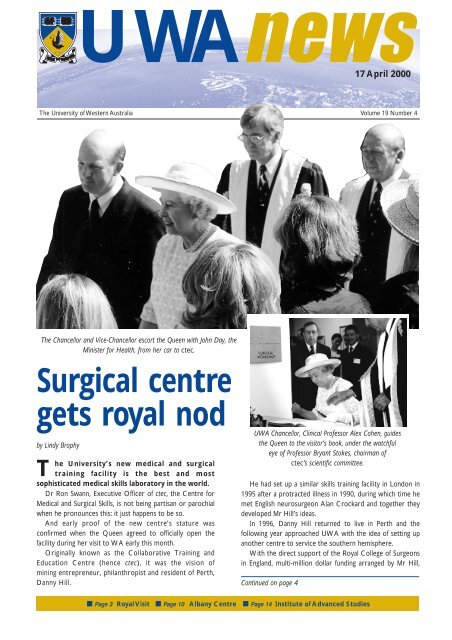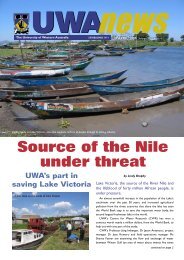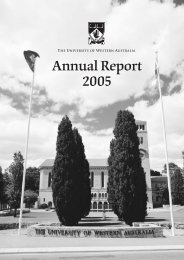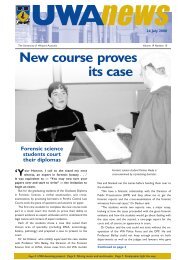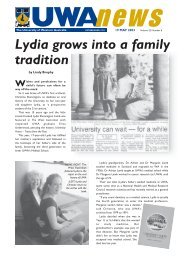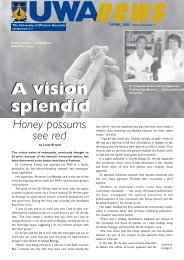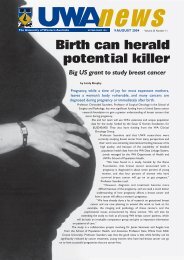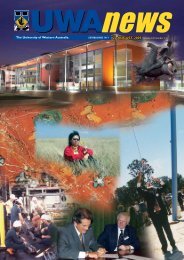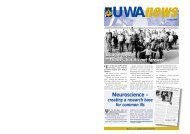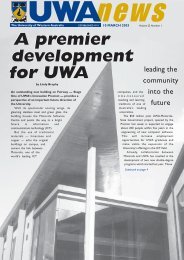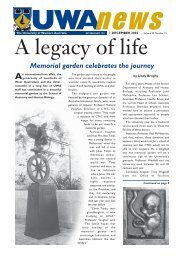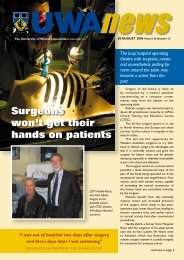NEWS 17 APRIL - UWA News staff magazine - The University of ...
NEWS 17 APRIL - UWA News staff magazine - The University of ...
NEWS 17 APRIL - UWA News staff magazine - The University of ...
- No tags were found...
You also want an ePaper? Increase the reach of your titles
YUMPU automatically turns print PDFs into web optimized ePapers that Google loves.
<strong>UWA</strong><strong>17</strong>newsApril 2000<strong>The</strong> <strong>University</strong> <strong>of</strong> Western Australia Volume 19 Number 4<strong>The</strong> Chancellor and Vice-Chancellor escort the Queen with John Day, theMinister for Health, from her car to ctec.Surgical centregets royal nodby Lindy Brophy<strong>The</strong> <strong>University</strong>’s new medical and surgicaltraining facility is the best and mostsophisticated medical skills laboratory in the world.Dr Ron Swann, Executive Officer <strong>of</strong> ctec, the Centre forMedical and Surgical Skills, is not being partisan or parochialwhen he pronounces this: it just happens to be so.And early pro<strong>of</strong> <strong>of</strong> the new centre’s stature wasconfirmed when the Queen agreed to <strong>of</strong>ficially open thefacility during her visit to WA early this month.Originally known as the Collaborative Training andEducation Centre (hence ctec), it was the vision <strong>of</strong>mining entrepreneur, philanthropist and resident <strong>of</strong> Perth,Danny Hill.<strong>UWA</strong> Chancellor, Clinical Pr<strong>of</strong>essor Alex Cohen, guidesthe Queen to the visitor’s book, under the watchfuleye <strong>of</strong> Pr<strong>of</strong>essor Bryant Stokes, chairman <strong>of</strong>ctec’s scientific committee.He had set up a similar skills training facility in London in1995 after a protracted illness in 1990, during which time hemet English neurosurgeon Alan Crockard and together theydeveloped Mr Hill’s ideas.In 1996, Danny Hill returned to live in Perth and thefollowing year approached <strong>UWA</strong> with the idea <strong>of</strong> setting upanother centre to service the southern hemisphere.With the direct support <strong>of</strong> the Royal College <strong>of</strong> Surgeonsin England, multi-million dollar funding arranged by Mr Hill,Continued on page 4■ Page 3 Royal Visit ■ Page 10 Albany Centre ■ Page 14 Institute <strong>of</strong> Advanced Studies
<strong>UWA</strong> news 3Hats and heat herald Her Majesty<strong>The</strong> last hot day <strong>of</strong> summer gave a veryAustralian flavour to the Royal visit.<strong>University</strong> <strong>staff</strong> in academic gowns were ushering invitedguests to their seats more than an hour before the Queenwas due to arrive, but shelter from the sun, rather than thebest vantage point, was what the early birds sought.Chairs closest to the spot where the Royal Rolls wouldstop, <strong>of</strong>fering perhaps the best view <strong>of</strong> Her Majesty, wererejected in favour <strong>of</strong> more comfortable seats under thehuge sail providing shade over the forecourt <strong>of</strong> the newbuilding.Hats made a comeback, as they always do for Royaltours, but there wasn’t a glove in sight until the Queenstepped out <strong>of</strong> the Vice Regal Rolls Royce sporting a lightgreen patterned dress, green hat and white gloves.Staff and students from the School <strong>of</strong> Music entertainedthe invited guests while they waited and students with bigProsh banners welcoming “King Richard III” (could this be areference to the Premier, Richard Court?) amused severalhundred onlookers safely behind police-patrolled barriers.Madeleine Warren, attendingthe opening with hergrandmother, Corin Lamont,had a posy for the Queen… just in case.A modest white car with a police escort April-fooled thecrowd, some <strong>of</strong> whom waved and cheered, only to find aless famous man emerging from it and striding away.Students gave Her Majesty an “Aussie Aussie Aussie, OyOy Oy!” chant when her car drove past the Guild. <strong>The</strong>Aboriginal flag, which had been flying at the Centre forAboriginal Programmes, just the day before, was missing onSaturday morning.<strong>The</strong> Queen’s walk down the red carpet whichtransformed the carpark, her meeting <strong>of</strong> the Chancellor, theVice-Chancellor, the Minister for Health, ctec benefactorDanny Hill, and others went smoothly and some <strong>of</strong> theshortest speeches ever heard on campus followed.After she had drawn the curtain to reveal thecommemorative plaque, Her Majesty went inside the buildingfor a tour, but did not visit the Hill International Medical andSurgical Workshop. Apparently she, like other members <strong>of</strong>the Royal family, favours homeopathy over orthodoxmedicine and doesn’t enjoy anything the least bit gory orsuggestive <strong>of</strong> invasive procedures.Her Majesty did however put her hand on “the best videogame in the world” in ctec’s virtual reality room. <strong>The</strong>computerised teaching system, which is being evolved incollaboration with the CSIRO, gives realistic “pressurefeedback” to trainee surgeons.“Oh I can feel it,” she said, delighting the scientists whoare developing the world-leading system.Outside, the guests were practising the Aussie wave,fanning themselves with their programs, while the music <strong>staff</strong>and students played on bravely.MC Peter Leunig, Office <strong>of</strong> Development manager,commented, as they began to play Vivaldi’s Autumn, from hisFour Seasons suite, that perhaps they should be playing Summer.Policewomen chose a dozen small children from thepublic crowd to meet the Queen and present her withflowers. <strong>The</strong>y waited, some not so patiently, on the hotbitumen, with one little barefooted girl sensibly hopping onthe lighter-coloured footpath.As the Queen emerged from the building to polite cheers(and some muffled shouts from underneath the Proshbanners) and accepted the children’s flowers, a Royalfollowingphotographer said: “You know, it’s not bad. Youcan get closer to the Queen than you can to Madonna!”THE UNIVERSITY OF WESTERN AUSTRALIA
4 <strong>UWA</strong> news‘ … a collaboration<strong>of</strong> unprecedentedproportions inAustralia …’Continued from page 1Surgical centregets royal nodand the partnership <strong>of</strong> <strong>UWA</strong>, the RoyalAustralasian College <strong>of</strong> Surgeons, theHealth Department <strong>of</strong> WA and theCentre for Anaesthetic Skills andMedical Simulation (CASMS), ctec was acollaboration <strong>of</strong> unprecedentedproportions in Australia.Early planning by the then Head <strong>of</strong>Anatomy and Human Biology,Associate Pr<strong>of</strong>essor Neville Bruce, andthe then Honorary Director (nowMedical Director) <strong>of</strong> ctec, Dr RichardVaughan, was encouraged by Mr Hill,Pr<strong>of</strong>essor Alan Robson, Martin Griffith(now Chairman <strong>of</strong> the Board) and DrBrent Donovan (Director <strong>of</strong> CASMS).Three years <strong>of</strong> planning haveresulted in a unique $<strong>17</strong>.5 milliontraining facility for both undergraduateand postgraduate surgeons, anaesthetists,medical doctors, nurses anddentists.<strong>The</strong> Hill International Medical andSurgical Workshop has ten fullyoperational operating rooms in one biglaboratory complete with simulatedtorsos, limbs and joints on whichsurgeons can practise their skillswithout putting patients at risk.Incredible as it may seem to thoseoutside the medical and surgicalpr<strong>of</strong>ession, surgical training until theadvent <strong>of</strong> skills training facilities like ctecconsisted <strong>of</strong> “watch one (operation orprocedure), assist with one, do one”.German philanthropist Sybil Storz,who owns one <strong>of</strong> the world’s biggestendoscopic companies, has donatedtwo million dollars worth <strong>of</strong> equipmentto the Hill Workshop.Workshop technical manager PeterMcIntosh, who has worked with boththe Storz company and the RoyalCollege <strong>of</strong> Surgeons in London, saidthat Mrs Storz was, like Danny Hill,dedicated to the training <strong>of</strong> surgeons.It is expected that more than 2000surgeons will attend surgical skillscourses at the HillWorkshop over thenext year.Dr Swann said thatthe centre’s telemedicinefacility had already runsurgical courses linkingoperations at QEII andSt John <strong>of</strong> God Hospitalwith medical schools inBallarat, Hong Kong,Singapore and London.Dr Ron Swann, ctec’sExecutive Officer, in theCASMS operating theatre,with SAM (SimulatedAnaesthesia Mannequin).“<strong>The</strong> idea <strong>of</strong> telemedicine is thatsurgeons can watch an operation takingplace and follow the exact proceduresat the same time, on a cadaver,”explained Dr Swann.Master classes will be run from theHill Workshop, with international videoand computer links, by, among others,Alan Crockard, the neurosurgeon wh<strong>of</strong>irst listened to the ailing Danny Hill’svision for training surgeons.Upstairs from the Hill Workshop isthe Centre for Anaesthesia Skills andMedical Simulation (CASMS), previouslylocated at RPH.Operating rooms, emergency wardsand intensive care units are all video-THE UNIVERSITY OF WESTERN AUSTRALIA
<strong>UWA</strong> news 5simulator for practising gall bladderremoval using keyhole surgery will beavailable within 18 months.“We can’t get the surgeons <strong>of</strong>f it,”laughed Ron Swann. “It’s the best videogame in the world!”Completing ctec is a laboratorydevoted to spinal cord regenerationand <strong>UWA</strong>’s highly acclaimedneuroscience group is bringing worldexpert Dr Giles Plant back from theMiami Project to run the laboratory,which is not yet ready for operation.Peter McIntosh, the Hills Workshop’s technical manager, demonstrates endoscopic surgicalprocedures on a simulated torso.linked and connected to a courtyardwhere medical emergencies can besimulated. A car was recently lifted bycrane into the first floor courtyard forsimulation <strong>of</strong> road accidentemergencies.A Simulated Anaesthesia Mannequin(SAM) in the operating room canbe manipulated by computers in anadjoining room to simulate reactionsto surgical and anaestheticprocedures.“But you can only go so far withplastic,” said Dr Swann, “and that’swhere the virtual reality room comesin. We are developing with the CSIROa fantastic new groundbreaking system<strong>of</strong> teaching, which uses virtual realityand ‘pressure feedback.’“Three-dimensional images arecombined with a sense <strong>of</strong> touch.Surgeons sit at the Haptic workbenchwearing 3D glasses. <strong>The</strong>y take hold <strong>of</strong>an instrument at the end <strong>of</strong> a roboticarm and miniature motors control theway the arm responds to movement <strong>of</strong>the tool.“This creates resistance, giving theuser the sensation that s/he is reallytouching, slicing, injecting, depending onthe procedure being followed.” DrSwann said.<strong>The</strong> virtual reality technology isbeing developed by CSIRO and hi-techSwedish company ReachIn Technologies.So far, ctec has only a hand simulator,but elbows and necks will follow, and aGraduationsHonouringleaders intheir fields<strong>The</strong> <strong>University</strong>’s consultingarchitect, Gus Ferguson, wasamong four recipients <strong>of</strong>honorary doctorates at therecent graduation ceremonies.Mr Ferguson delivered theoccasional address at theEngineering and MathematicalSciences graduation and was madean Honorary Doctor <strong>of</strong> Architecture.Honorary Research FellowPr<strong>of</strong>essor George Seddon, from theDepartment <strong>of</strong> English, was awardedan honorary Doctor <strong>of</strong> Letters atthe Economics and Commerce, andLaw graduation ceremony.An honorary Doctorate <strong>of</strong>Science was conferred on thespeaker at the Science ceremony,Pr<strong>of</strong>essor Athelstan Beckwith.Rabbi Dr Shalom Colemanaddressed the final ceremony andwas awarded the honorary degree<strong>of</strong> Doctor <strong>of</strong> Laws.Do you enjoy swimming? Want to improve your fitness and style? <strong>The</strong>n join theWe train Tuesday and Thursday mornings (7.15 to 8.30am) at the HumanMovement Pool, right here on campus. All abilities are catered for.Cost*: $70/year, or $45/semester ($60/year if you bring this ad.)Includes pool entry and coaching fees.For more information contact Sarita Bennett (9380 7353)*Prerequisite: Sports Card.<strong>UWA</strong>SwimmingClubTHE UNIVERSITY OF WESTERN AUSTRALIA
<strong>UWA</strong> news 7Children sendtheir motherback to school<strong>The</strong> family who studies together . . . fightsover the family computer!“But luckily, I’m an early morning person and mychildren are all night owls,” said Lois Hall, who graduated inthe same week as one <strong>of</strong> her sons.“<strong>The</strong> only problem was when Mum would get up early towork and I’d still be at the computer, havingbeen there all night,” said her son KaneArundale, who received his Bachelor<strong>of</strong> Science, with a double major inpharmacology and physiology.His mother graduated withfirst class honours inAnthropology after adouble major in politicsand anthropology.Her eldest daughter,Melanie, has two degreesfrom <strong>UWA</strong>, a BA inpolitics and a Bachelor <strong>of</strong>Psychology. She nowworks at the <strong>University</strong>,in the Admissions Centre.Another sibling is studyinginformation technology andmarketing at Curtin <strong>University</strong>.“We had to keep out <strong>of</strong> each other’s way while wewere all studying,” Mrs Hall said. “I decided to go back toschool and then on to <strong>University</strong> because I felt my kidswere leaving me behind. We’d got to the stage where theyall knew more than me, but I don’t regret for a minutehaving spent all those years at home not working orstudying, but being the best mother I knew how.“And I would do it again. Full-time mothering is highlyunderrated.”Mrs Hall is now planning to go one step further than herchildren and is considering starting a PhD in August.Melanie Arundale ensuresher brother Kane andmother Lois Hall havetheir gowns right for theirgraduation ceremony.First marine scientist for <strong>UWA</strong>Brendon Ward had always loved the ocean but a career in marine sciencewas far from his mind when he left school at the age <strong>of</strong> 15.Now, after travelling Australia and the world with his wife Jane, working in variousjobs and going back to school to complete his TEE, Mr Ward has graduated with aBachelor <strong>of</strong> Science in Marine Science.He is <strong>UWA</strong>’s first Marine Science graduate. A few others who started thecourse at the same time, three years ago, have gone on to do honours, but,despite being <strong>of</strong>fered honours by three faculties, Mr Ward decided tograduate and join the work force.He is now part <strong>of</strong> the Department <strong>of</strong> Environmental Protection’scatchment management group — and is loving it.“Of the three streams in marine science, marine biology is probablythe most popular and coastal management makes you most employable.But I chose coastal and marine geoscience, which is a mix <strong>of</strong> geologyand oceanography,” Mr Ward said.“<strong>The</strong> geology side fascinated me and I felt that this stream gave me thenecessary depth <strong>of</strong> understanding while I can always pick up the managementside <strong>of</strong> the industry while I’m working in it.”He paid tribute to Mrs Ward, who has put her PhD in clinical psychology onhold while her husband completed his degree.Brendon and Jane Ward . . . supportingeach other in their studies.THE UNIVERSITY OF WESTERN AUSTRALIA
<strong>UWA</strong> news 9ADVANCE NOTICEMonday 1 MayMay - Junesnightly.blicationanna Thompson,nit,x 1162,ing.uwa.edu.auairs on 9380 2889.r charge is specified,d here are free andt media interest.around in thedays.or George Stewartcturers on Me Noad shaved to raiseresearch.tewart (picturede Pr<strong>of</strong>essor Markfessor BrendanPr<strong>of</strong>essor Ge<strong>of</strong>fman Biology), Drlogy) and Dr Ian00 and are feelingemselves but a bits.SCIENCE FILM SHOW“Can the Olympics be drug free?” In this timely program,the issue <strong>of</strong> drugs in sport will be explored. 1.05pm,Geography Lecture <strong>The</strong>atre 1.HISTORY SEMINAR“Beaches <strong>of</strong> the mind: writing rather than ‘doing’ history”,Pr<strong>of</strong>essor Greg Dening, ANU. 4.30pm, PostgraduateLounge, Hackett Hall.CHAMBER MUSIC CONCERT<strong>The</strong> Blackwood River Chamber Festival in associationwith the School <strong>of</strong> Music presents guest artists from thisyear’s festival. Performers include Jane Edwards, MichaelLeighton Jones, Anna Sleptsova, Barbara Jane Gilby andthe Tank Stream String Quartet. Tickets are $22.50 and$<strong>17</strong>.50. Enquiries to 9761 2772 or fax 9761 4151. 8pm,Callaway Music Auditorium.Tuesday 2 MayINFORMATION MANAGEMENT AND MARKETINGSEMINAR“Internet issues today”, Kimberley Heitman, ElectronicFrontiers Australia and Julia Bishop. 6.30pm, EconomicsConference Room.Wednesday 10 MayPERTH MEDIEVAL AND RENAISSANCE GROUPQUIZ NIGHT<strong>University</strong> House at 7.30pm, $6 per person, tables <strong>of</strong> sixat $30. Bookings to Dr Emma Hawkes, History, or callCharles Acland at Kingswood College on 9423 9428.FACULTY OF AGRICULTURE OLIVE ACTIVITIESTable Olive Workshop 2000This one-day workshop, which costs $125 per person, willbe held at <strong>UWA</strong> on Sunday May 7. <strong>The</strong> workshop coversgrowing and processing table olives, hands-on activitiesmaking cracked, chilli olives and tapenade, evaluating tableolive products and an introduction to the MediterraneanDiet.International Olive School 2000This six-day live in school, which costs $1000 per personand includes all meals and accommodation, will be held atNew Norcia from Sunday June 11 to Friday June 16. <strong>The</strong>school covers all aspects <strong>of</strong> olive growing, olive oil andtable olive products. Both didactic and hands-on activitieswill be presented by national and international olivespecialists.4th Olive Cultural and Scientific SymposiumThis three-day live in symposium, which costs $370 perperson and includes all meals and accommodation, will beheld at New Norcia starting at 7pm on Friday June 16 andfinishing 4pm on Sunday June 18. Saturday only registrationis also available. International, national and local speakerswill present current information on olive growing, olive oilproduction and marketing <strong>of</strong> olive products. Much <strong>of</strong>Sunday <strong>17</strong> is set aside for practical demonstrations in theolive grove. Cultural activities include: visits to the NewNorcia bakery, museum and historic buildings; Mass,prayers and c<strong>of</strong>fee with the Benedictine Monks; and anAustralian bush breakfast on Sunday.For further information please contact Pr<strong>of</strong>essorStan Kailis at the Faculty <strong>of</strong> Agriculture.Telephone 9380 1644; facsimile: 9380 1108;email: skailis@agric.uwa.edu.auBERLIN WALL A COMPETITION WINNERLate last year Dr Alexandra Ludewig <strong>of</strong> German Studies in the Department <strong>of</strong> EuropeanLanguages and Studies organised a poster competitionfor Year 7 to 11 students <strong>of</strong> German in Western Australia.<strong>The</strong> topic was simply “Made in Germany”.<strong>The</strong> response from school students was overwhelming and, as aresult, German Studies decided to award a $20 book voucher tothe best three entries from each year.More than 200 people attended the vernissage, enjoyeddrinks and nibbles and witnessed the judges at work.<strong>The</strong> judging panel comprised politicians, diplomatsand business people. Julie Bishop (Curtin MP), BillHassell (Honorary Consul <strong>of</strong> the Federal Republic <strong>of</strong>Germany), Werner Brandt (Vice-Consul <strong>of</strong> theFRG), Andreas Walewski (President <strong>of</strong> the WestAustralian German Business Association)and Dr Annette Harres(lecturer at <strong>UWA</strong> and Committeemember <strong>of</strong> the Goethe Society)were on the panel.<strong>The</strong> overall winners were fivestudents from Kelmscott SeniorHigh, who had entered with ahuge piece <strong>of</strong> the Berlin Wallgiving way in the middle and thusopening up new possibilities for Germanindustry and technology especially in Eastern Europe.Students from Kelmscott Senior High proudly show <strong>of</strong>f their winning entry.THE UNIVERSITY OF WESTERN AUSTRALIA
10 <strong>UWA</strong> news ALBANY FEATURE<strong>UWA</strong>Albany CentreDr Billie Giles-Cortiis one <strong>of</strong> thereasons <strong>UWA</strong> is sopopular in Albany.<strong>The</strong> enthusiasm for <strong>UWA</strong>’sAlbany Centre in the ruralcity is tangible.<strong>The</strong> local council, industries andindividuals have provided or have on<strong>of</strong>fer library space, scholarships, fundingand support <strong>of</strong> every kind.Albany is so keen on its new linkswith the <strong>University</strong> that its people arealmost falling over themselves to helpout.“It’s humbling,” says Albany Centredirector Dr Billie Giles-Corti.“When we started, just over a yearago, I felt uncomfortable asking peoplefor help. <strong>The</strong>n I realised that everybodyis so excited about being involved.”<strong>The</strong> dynamic Albany Centre has 15first-year units on <strong>of</strong>fer this semesterto its 41 undergraduate students. <strong>The</strong>units are from the Faculties <strong>of</strong> Arts,Economics and Commerce, Scienceand Engineering and MathematicalSciences.<strong>UWA</strong> ajewel inthesouthOf the 53 students (comparedwith 33 last year), 23 areHECS undergraduate students(seven last year), six <strong>of</strong> themfull-time and the remainderstudying between one and threeunits.<strong>The</strong>re are 14 continuingeducation students, two <strong>of</strong> whomare studying full-time, 16 Master <strong>of</strong>Education students and oneMaster <strong>of</strong> Arts student.Undergraduates include fourschool leavers.“<strong>The</strong> challenge is to attractfull-time students and schoolleavers,” Dr Giles-Corti said.“We are developing a fiveyearplan and we hope tohave 200 students (not all <strong>of</strong> them fulltime)enrolled at the end <strong>of</strong> thatperiod.”<strong>The</strong> challenges <strong>of</strong> running a rural<strong>University</strong> centre have changed overthe past 12 months. First, problemswith technology and delivery <strong>of</strong>lectures was the biggest headache,coupled with marketing the centre andattracting students.Although it’s still not 100 per centsmooth, the technology for deliveringeducation is state-<strong>of</strong>-the-art and iskeeping the <strong>staff</strong> at the Faculty <strong>of</strong> ArtsMultimedia Centre and DUIT on theirtoes.Dr Giles-Corti explained thelatest innovation: “Thanks to thehard work and tenacity <strong>of</strong> TerryCoe from the Audio Visual Unit andMike Neville and Mike Fardon fromthe Multimedia Centre, the upgrade<strong>of</strong> the lecture theatres on Nedlandscampus is now complete.“This upgrade enables most <strong>of</strong> thelectures required for the Albanyeducational program to be centrallydigitised and placed on the web.“Lecturers can easily delivercomputer-aided lectures and haveaccess to a ‘visualiser’. <strong>The</strong> visualiserwill be used for subjects in whichlecturers traditionally write on theblackboard or on an overhead.“<strong>The</strong> hand-written text will beprojected overhead for Perth studentswhile, for students in Albany, thehandwriting will be videotaped (fiveframes per second), digitised and placedon the web.“This is ground-breaking use <strong>of</strong>technology and I sincerely thank MikeFardon (Multimedia Centre) and DrDoug Pitney (Mathematics andStatistics), both <strong>of</strong> whom were trialingthe technology during the summerbreak.”During the first five years <strong>of</strong> theAlbany Centre, the aim is to providethe widest possible range <strong>of</strong> first-yearsubjects, followed by second-yearsubjects and to attract school leavers toenrol for their first year or two “athome”.“<strong>The</strong> locals are very keen onpostgraduate research studies beingdone here because they’re desperatefor region-based research,” Dr Giles-Corti said.But that is not the priority for2000.For now, the centre is extremelyfortunate that Alan Dodds made themove from Perth (Multimedia Centre)to Albany with his family before thecentre opened and is the cornerstone<strong>of</strong> the technological development.Deputy Vice-Chancellor Pr<strong>of</strong>essorAlan Robson, who visited Albanyrecently for a planning meeting andpresentation <strong>of</strong> scholarships, saidnothing could replace the campusexperience for university students.He is keen for Albany students tostart their tertiary education at home,then move up to Perth for the finalyear or two <strong>of</strong> a degree.Later, there is the possibility thatthis might even be reversed, with Perthstudents beginning a course in, sayforest science, then completing it inAlbany with the relevant field workdone virtually on site.ALBANY FEATURESee also pages 11, 12 and 13THE UNIVERSITY OF WESTERN AUSTRALIA
12 <strong>UWA</strong> news ALBANY FEATURE<strong>UWA</strong> Albany CentreUNIVERSITYHAS STRONGFOUNDATIONSSteve Birkbeck calls himself the “human face” <strong>of</strong>the Albany <strong>University</strong> Foundation.“I’ll be up front. I have three primary school-aged girlsand I would love to see them able to start universityeducations without leaving home,” said the founder andCEO <strong>of</strong> Mt Romance, a manufacturer <strong>of</strong> sandalwood oilproducts.Although a prominent businessman in the Albany region, MrBirkbeck had always shied away from joining local committees.“I felt they always divided the community. But when I wasapproached to be part <strong>of</strong> the <strong>University</strong> Foundation, I knewthat the establishment <strong>of</strong> the <strong>University</strong> here was a coreissue that would unite the community, not divide them,” hesaid.Mt Romance has a $2.5 million annual turnover with a<strong>staff</strong> <strong>of</strong> 35 and a huge growth potential. Its business partnersinclude UniSuper, BHP and Macquarie Bank. <strong>The</strong> possibility<strong>of</strong> local industry-driven and funded research happening atthe <strong>UWA</strong> Albany Centre has excited not just Mr Birkbeckbut many people involved with primary and secondaryindustry in the Great Southern region.“Initially I was pushing hard for postgraduate research,until Billie (Giles-Corti) brought me back down to earth andhelped me realise that undergraduate courses were the firstpriority for the centre, then we will focus on research,” MrBirkbeck said.“I still see local postgraduate research as providing theultimate benefit to the community, but I have taken theopposite direction to start with: I’ve gone back down thetrack to primary school!“Mt Romance, through the Foundation, is <strong>of</strong>fering scienceprizes to Year 7 and Year 10 students at local Albanyschools. For top students in Year 12, we are <strong>of</strong>feringscholarships to study at the <strong>UWA</strong> Albany Centre, with somespecial incentives for Aboriginal students.“<strong>The</strong> Foundation hopes to help supply the bridgebetween school and university. We are also looking at<strong>of</strong>fering scholarships for <strong>UWA</strong> Albany students who do wellin their first year here, to help them make the move toPerth to complete their courses. <strong>The</strong> retention rate insecond year will be the test,” he said.<strong>UWA</strong> Foundation chairman Steve Birkbeck inspects afractionation column at his sandalwood oil plant.“<strong>The</strong> community gets its pay-back when the <strong>University</strong>introduces its postgraduate program, with community- andindustry-driven research.”That program is scheduled to start at the Albany Centrewithin 12 months. It is clear to Dr Giles-Corti and toeverybody involved with the <strong>University</strong> that the GreatSouthern region <strong>of</strong>fers many research opportunities.“Postgraduate research will definitely be regionally basedand supported and will probably start in the area <strong>of</strong> naturalresource management,” Dr Giles-Corti said.Natural resource management (NRM) is a major focus forindustry and development in the Albany region and an NRMCentre for Excellence is planned by the Southern ProvinceRegional Development Organisation in collaboration with<strong>UWA</strong> and other local NRM agencies.At present, the Albany <strong>University</strong> Foundation raisescorporate sponsorship and lobbies politicians for theirsupport in developing the centre. <strong>The</strong> next step will possiblybe the appointment, by the Foundation, <strong>of</strong> an executive <strong>of</strong>ficerspecifically to raise funds for the Foundation’s activitiesincluding funding for postgraduate research and scholarships.THE UNIVERSITY OF WESTERN AUSTRALIA
14 <strong>UWA</strong> newsCLASSIFIEDSTO LETCHARACTER HOME IN EAST FREMANTLE, 2 bedroom, 1 bathroomwith study and garden, fully furnished in friendly neighbourhood. Washer,microwave, tv/video/stereo, gas heating. $250 p/w. Available 1 July to 31December. Suit sabbatical visitor. Please phone Clive on 9339 <strong>17</strong>70 (h) orext. 3257 (w).BRAND NEW HOME IN SCARBOROUGH, 3 bedrooms, 2 bathrooms,ideally located near shops and beach. Unfurnished and available for longtermrental from April onwards. $280 p/w. Contact Jo at home on 92452530.WANTED TO RENTFLAT OR HOUSE, preferably unfurnished for rent over the period fromJuly 1 to Christmas 2000 for <strong>UWA</strong> academic couple with a 5 year old son,currently on leave at <strong>University</strong> <strong>of</strong> Copenhagen. Must be close to <strong>UWA</strong>.Contact: Jakob B Madsen on jmadsen@ecel.uwa.edu.au or +45 35 32 30 75.FOR SALELOUNGE SUITE, DK green vinyl, 2 x 2.5 seater and 1 chair, plus cornertable all matching. Excellent condition. $550 ono. Call Marisa on ext. 1927or 9248 4469.CallKenataRentalsand book a one, two or three bedroom townhomeabsolutely fully equipped with everything! Short or longstay. From $350 per week, including all amenities.Location: cnr Fairway and Edward Streets, Crawley(opposite Mechanical Engineering)Enquiries: 0412 953 100 or fax 9389 8326It won’ttake aminute …It looked an easy enough jobfor a woman and a piece <strong>of</strong>rope. Just one little deadbranch caught on anotherbranch in a tree in theNumber 1 carpark. But ittook another three people, aladder and eventually a smalltractor, to dislodge it. We allhave those days, where thesimplest tasks turn intoirritating time-gobblers . . .Kenata Rentals providing short term, fully furnished accommodation to <strong>UWA</strong> since 1982.2001RAINE PRIMING GRANTSApplications are invited for Raine Priming Grants in accordance with the Guidelines governing the awards,and include provision for New Project Grants as defined in the Guidelines. <strong>The</strong> Grants* shall provide fundingfor research into any area <strong>of</strong> medical science that investigates the nature, origin and cause <strong>of</strong> human disease,and the prevention, cure, alleviation and combating <strong>of</strong> such disease.Grants shall be <strong>of</strong>fered for a two-year period, subject to annual review.Grants may be used to provide funding, or part funding, <strong>of</strong> salaries for researchers and/or technical <strong>staff</strong>,computing, and consumables.Major items <strong>of</strong> equipment will not be financed.<strong>The</strong> research shall be carried out at, or in association with, <strong>The</strong> <strong>University</strong> <strong>of</strong> Western Australia.Guidelines and Application Forms are available from:Raine Medical Research FoundationSuite 24, 95 Monash Avenue, Nedlands, WA 6009Hollywood Specialist CentreTelephone: 9386 9880Fax: 9386 9522; email: raine@raine.uwa.edu.auWeb site: www.raine.uwa.edu.auApplication forms must be received at the above <strong>of</strong>fice no later than Monday 1 May 2000 at 5pm* Raine Priming Grants are intended for: (a) less experienced researchers, (b) researchers wishing to move ina different scientific direction, and (c) new academic research <strong>staff</strong> to <strong>The</strong> <strong>University</strong> <strong>of</strong> Western Australia.THE UNIVERSITY OF WESTERN AUSTRALIA
<strong>UWA</strong> news 15AUSTRALIAN RESEARCH COUNCILA/Pr<strong>of</strong>. Jie Pan, Mechanical and MaterialsEngineering: “Band-limited energy flow incoupled structures” — $46,067 (2000); $42,769(2002); $44,841 (2002).Dr Anya M. Waite, Environmental Engineeringand Dr P. Boyd (external): “Controls andimpacts <strong>of</strong> organic particle aggregation in aquaticsystems” — $60,000 (2000); $30,000 (2001/2).Pr<strong>of</strong>. David Russel Badcock and Pr<strong>of</strong>. J.Ross, Psychology: “Detecting, interpreting andcompleting complex pattern and motion” —$45,500 (2000); $52,000 (2001); $46,000 (2002).Pr<strong>of</strong>. Patricia Marcia Crawford, History:“Families and gender roles in England 1550-<strong>17</strong>80” — $35,000 (2000); $16,000 (2001);$29,500 (2002).Dr Lincoln Heinze Schmitt, Anatomy andHuman Biology and Dr R. A. How (external):“Impact <strong>of</strong> geographic, environmental andhistorical parameters on vertebrate diversity andevolution at the Oriental-Australian interface” —$42,000 (2000/1); $43,000 (2002).Dr Matthew Charles Wilce and Dr J. M.Newman, Pharmacology: “Intelligent proteinengineering: learning from enzyme evolution” —$62,000 (2000); $50,092 (2001); $49,954 (2002).Pr<strong>of</strong>. Yianni Attikiouzel, Electrical andElectronic Engineering: “Intelligent search,detection and classification <strong>of</strong> lesions onmammograms” — $56,000 (2000); $58,000(2001); $60,000 (2002).Pr<strong>of</strong>. Lorenzo Faraone and Dr John MarcelDell, Electrical and Electronic Engineering, andPr<strong>of</strong>. S. Sivananthan, Physics: “Investigations<strong>of</strong> mercury cadmium telluride heterojunctioninterfaces for semiconductor device applications”— $85,000 (2000); $80,000 (2001/2).Pr<strong>of</strong>. Paul William Miller, Economics:“Neighbourhood effects and the immigrantadjustment process” — $57,500 (2000); $59,500(2001); $54,000 (2002).Dr Michael Edmund Tobar, Physics: “Novelhigh-stability frequency synthesis for highprecision fundamental physics experiments” —$80,000 (2000); $74,000 (2001); $81,000 (2002).Pr<strong>of</strong>. Michael John Mcaleer, Economics:“Robust estimation and testing <strong>of</strong> volatilitymodels in economics and finance” — $44,337(2000); $34,337 (2001); $26,337 (2002).A/Pr<strong>of</strong>. Albert Yousif Zomaya, Electrical andElectronic Engineering: “Scheduling in thepresence <strong>of</strong> contention and communicationdelays for parallel computing systems” —$52,000 (2000); $53,000 (2001); $55,000 (2002).Pr<strong>of</strong>. Paul Kim Kirsner and Pr<strong>of</strong>. KevinAlfred Durkin, Psychology and Dr JohnCameron Dunn, Psychiatry and BehaviouralScience: “Situated memory: transmission andtransformation <strong>of</strong> knowledge about real events”— $30,500 (2000).Dr Xiao Zhi Hu, Mechanical and MaterialsEngineering: “Size effect on fracture energy inbrittle matrix composites” — $46,067 (2000);$48,116 (2001); $50,446 (2002).Pr<strong>of</strong>. Colin Macleod, Psychology: “<strong>The</strong>cognitive basis <strong>of</strong> individual differences insusceptibility to develop elevated trait anxiety”— $74,500 (2000); $73,000 (2001); $60,000(2002).Research&GrantsContractsPr<strong>of</strong>. Brian James Stone, Mechanical andMaterials Engineering: “<strong>The</strong> control <strong>of</strong> unstablevibration in grinding” — $51,185 (2000); $53,462(2001).Pr<strong>of</strong>. David Russel Badcock, Psychology:“<strong>The</strong> dependence <strong>of</strong> motion perception on thespatial properties <strong>of</strong> the moving object” —$30,500 (2000); $30,000 (2001); $31,000 (2002).Dr Jakob Brochner Madsen, Economics: “<strong>The</strong>Great Depression <strong>of</strong> the 1930s: causes,international transmission and implications forthe Asian Financial Crisis in the late 1990s” —$44,000 (2000/1); $25,000 (2002).Dr Andre Nicholas Luiten, Physics: “Towardsthe optical time standard” — $100,000 (2000);$115,000 (2001); $55,000 (2002).Dr Loretta Virginia Baldassar, Anthropologyand Pr<strong>of</strong>. C. Baldock (external): “Transitionalcare-giving: cross-cultural aged care practicesbetween Australian immigrants and their parentsliving abroad” — $44,000 (2000); $75,000 (2001)$48,000 (2002).Dr Peter Graeme Arthur, Biochemistry: “Amechanism to describe the sensitivity <strong>of</strong>mammalian cells to changes in oxygenconcentration” — $5790 (2000).AUSTRALIAN RESEARCH COUNCIL —SMALL GRANTSDr Alice Catherine Niemeyer and Pr<strong>of</strong>.Cheryl Elisabeth Praeger, Mathematics andStatistics: “Algorithms for soluble groups” —$15,620 (2000).Dr Andre Nicholas Luiten and Dr FrankJoachim Van Kann, Physics: “An innovativeand compact optical frequency standard” —$<strong>17</strong>,059 (2000).Dr Carolyn Elizabeth Oldham,Environmental Engineering: “Assessment <strong>of</strong> bioavailablephosphorus in wetland sediments” —$19,048 (2000).Dr Timothy Guy St Pierre, Physics:“Bioassays and biosensors based on the timedependentmagnetic properties <strong>of</strong>immunomagnetic fluids” — $18,500 (2000).Dr Charitha Bandula Pattiaratchi,Environmental Engineering: “Continental shelfprocesses between Shark Bay and North WestCape” — $15,981 (2000).Dr Dominique Blache, Animal Science andProduction: “Control <strong>of</strong> gonadotrophinsecretion by nutrition: roles <strong>of</strong> aromatization andreduction <strong>of</strong> androgens in brain tissue” — $5790(2000).Dr Allan James Mckinley, Chemistry: “DoZnP and MgP have 4E ground electronic states?”— $10,375 (2000).Dr Martin Luke Hazelton, Mathematics andStatistics: “Efficient stochastic simulation <strong>of</strong> roadtraffic models” — $11,200 (2000).Kees Willem De Winter and Pr<strong>of</strong>. C. E.Oxnard, Anatomy and Human Biology:“Evolutionary radiations and lifestyleconvergences in the internal proportions <strong>of</strong>mammalian brains” — $6790 (2000).Dr Liang Cheng, Civil and ResourceEngineering: “Experimental study <strong>of</strong> vortexinduced vibration <strong>of</strong> a pipeline bundle” —$12,950 (2000).Dr Emad Sahouryeh, Civil and ResourceEngineering: “Fluid flow through pressuresensitive fracture networks” — $15,090 (2000).Dr Ge<strong>of</strong>frey Alexander Stewart,Microbiology: “Gut-derived enzymes fromeconomically importnat mites: suitable targetsfor biological control in agriculture” — $13,000(2000).Dr Neal Jesse Mcnaughton, Geology andGeophysics: “High precision U-Pb geochronology<strong>of</strong> diagenetic phosphates: a pilot study” —$20,000 (2000).Dr Susan Marianne Spaargaren, Electricaland Electronic Engineering: “Investigation <strong>of</strong>defects in AIGaN/GaN structures by electronspin resonance spectroscopy” — $13,800(2000).Dr John Marcel Dell, Electrical and ElectronicEngineering: “Investigation <strong>of</strong> micro-mechanicalsystems for short distance opticalcommunications applictions” — $19,481 (2000).A/Pr<strong>of</strong>. David Douglas Sampson, Electricaland Electronic Engineering: “Investigation <strong>of</strong> theoptical properties <strong>of</strong> tissue in the 1-2 micronnear-infrared spectral range” — $20,000 (2000).More Research Grantsin the next issue.Enquiries through ResearchServices on 9380 <strong>17</strong>76.<strong>UWA</strong>newsPublished by<strong>The</strong> <strong>University</strong> <strong>of</strong> Western AustraliaDesigned and produced byPublications Unit<strong>The</strong> <strong>University</strong> <strong>of</strong> Western AustraliaEDITOR-IN-CHIEF/PUBLIC AFFAIRSColin Campbell-FraserTel.: 9380 2889 Fax: 9380 1020Email: cam@acs.uwa.edu.auEDITOR/FEATURE STORY WRITERLindy BrophyTel.: 9380 2436 Fax: 9380 1192Email: lindy.brophy@uwa.edu.auCAMPUS DIARY/ADVERTISING/CLASSIFIEDS/REDUNDANT EQUIPMENT/DISTRIBUTION LISTJo ThompsonTel.: 9380 3029 Fax: 9380 1162Email: uwanews@publishing.uwa.edu.auPrinted byUniprint<strong>The</strong> <strong>University</strong> <strong>of</strong> Western Australia<strong>UWA</strong>news onlinehttp://www.publishing.uwa.edu.au/uwanews/THE UNIVERSITY OF WESTERN AUSTRALIA
16 <strong>UWA</strong> newsScienceat theNewMillennium<strong>The</strong> first series <strong>of</strong> major activities by the Institute<strong>of</strong> Advanced Studies took place in March andprovided an auspicious start to a busy inaugural year<strong>of</strong> programs and one-<strong>of</strong>f events.Science at the New Millennium, one <strong>of</strong> the two programsfunded by the Institute in mid 1999, started with threediscrete components: the Octagon lecture series over threenights; the fourth International Centre for RelativisticAstrophysics (ICRA) workshop; and the visit by animpressive gathering <strong>of</strong> eminent scientists for the opening <strong>of</strong>the Australian International Gravitational Observatory atGingin (see the last issue <strong>of</strong> <strong>UWA</strong> <strong>News</strong> for the full story).<strong>The</strong> Public Lecture series, well attended by both <strong>UWA</strong> <strong>staff</strong>and students and the larger interested public, was a returnto the passionate interest in physics that was shown at theOctagon in 1988 when David Blair organised five lectures byscientists including Paul Davies. Back then, there were notenough seats to hold the crowds <strong>of</strong> interested people. Thistime, almost 1000 people attended over the three nights.This series welcomed back Remo Ruffini, a regular visitor toMichael BarberPRO VICE-CHANCELLOR (RESEARCH AND INNOVATION)INTERIM DIRECTOR, INSTITUTE OF ADVANCED STUDIES<strong>UWA</strong> over 20 years, as well as Barry Barish from the LIGOLaboratory at Caltech, one <strong>of</strong> the most distinguishedexperimental physicists in the USA, and Adalberto Giazott<strong>of</strong>rom the <strong>University</strong> <strong>of</strong> Pisa. This was just the sort <strong>of</strong>international series that we are striving for with theInstitute.<strong>The</strong> ICRA workshop, held for two days on campus,attracted a hugely impressive list <strong>of</strong> visitors from Europe, theUSA, and Australia. Some <strong>of</strong> the participants travelled acrossmany borders to arrive in Perth: including Pr<strong>of</strong>essor JimWilson from the Lawrence Livermore National Laboratoryin California, and Gurzadyan Vahe <strong>of</strong> the Yerevan PhysicsInstitute and Dr Richard Isaacson, a Programme Directorfrom the American National Science Foundation. As well, ahost <strong>of</strong> local government dignitaries from Italy attended tocelebrate Australia’s entry into the ICRA Network. This wasa brilliant opportunity for students to work with high-levelscientists in an intimate workshop setting.<strong>The</strong> ICRA web site (http://www.icra.it/Welcome.htm) hasfurther details <strong>of</strong> this workshop and features the dazzlingimage <strong>of</strong> artist Julie Weekes used on the IAS poster. Herpainting captured the attention <strong>of</strong> all <strong>of</strong> the visiting scientists.Pr<strong>of</strong>essor Barish made an allusion to it in his lecture, andeach <strong>of</strong> the visitors travelled to her Fremantle studio to seemore <strong>of</strong> her work. Look out for the second series posterfeaturing another <strong>of</strong> her works, this time on Stars and Cells,from the middle <strong>of</strong> the year.<strong>The</strong> next round <strong>of</strong> visitors to Science at the New Millennium isscheduled to arrive in October. Joseph Vacanti from theHarvard Medical School is visiting as a Raine DistinguishedPr<strong>of</strong>essor and will present a Public Lecture in early Octoberat the Octagon <strong>The</strong>atre. Pr<strong>of</strong>essor Vacanti is at the forefront<strong>of</strong> innovation in the area <strong>of</strong> Tissue Engineeringinternationally. Vacanti is currently hosting aresidency for Oran Catts and Ionat Zurr, two artistsfrom SymbioticA, <strong>UWA</strong>’s Anatomy and HumanBiology Collaborative studio.Later in the month two distinguished physicistswill visit — Thibault Damour from France’sInstitut des Hautes Etudes Scientifiques and hisclose colleague, Nobel Laureate Joseph H. Taylor<strong>of</strong> Princeton who continues to explore problemsin astrophysics and gravitational physics by means<strong>of</strong> radio-wavelength studies <strong>of</strong> pulsars. Pr<strong>of</strong>essorTaylor is also formerly a faculty member <strong>of</strong>Princeton’s famous Institute for Advanced Study.<strong>The</strong>se two Public Lectures are being planned forlate October.And by the way, for those <strong>of</strong> you who attendedthe Octagon lectures and were impressed withthe young boy who asked the astute and mostimpressive questions — he has been contacted toexplore the possibility <strong>of</strong> an ongoing relationshipwith science and <strong>UWA</strong>!…the last wordTHE UNIVERSITY OF WESTERN AUSTRALIA


